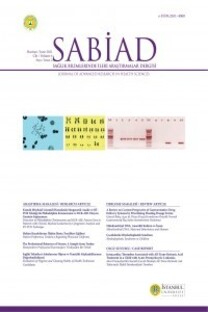PORSELEN LAMİNAT KAPLAMA HAKKINDA BİLGİ KAYNAĞI OLARAK YOUTUBE
Dental laminate, diş porseleni, diş kaplamaları, bilgi kaynakları
YOUTUBE AS A SOURCE OF INFORMATION ON PORCELAIN LAMINATE VENEERS
dental porcelain, dental veneers, information resources,
___
- 1. Peumans M, Van Meerbeek B, Lambrechts P, Vanherle G. Porcelain veneers: a review of the literature. J Dent 2000;28(3):163-77. google scholar
- 2. Akoğlu B, Gemalmaz D. Fracture resistance of ceramic veneers with different preparation designs. J Prosthodont 2011;20(5):380-4. google scholar
- 3. Fradeani M, Redemagni M, Corrado M. Porcelain laminate veneers: 6- to 12-year clinical evaluation--a retrospective study. İnt J Periodontics Restorative Dent 2005;25(1):9-17. google scholar
- 4. Calamia JR, Calamia CS. Porcelain laminate veneers: reasons for 25 years of success. Dent Clin North Am 2007;51(2):399-417. google scholar
- 5. Burke FJT. Survival rates for porcelain laminate veneers with special reference to the effect of preparation in dentin: a literature review. J Esthet Restor Dent 2012;24(4):257-65. google scholar
- 6. Hassona Y, Taimeh D, Marahleh A, Scully C. YouTube as a source of information on mouth (oral) cancer. Oral Dis 2016;22(3):202-8. google scholar
- 7. Madathil KC, Rivera-Rodriguez AJ, Greenstein JS, Gramopadhye AK. Healthcare information on YouTube: a systematic review. Health İnformatics J 2015;21(3):173-94. google scholar
- 8. Keelan J, Pavri-Garcia V, Tomlinson G, Wilson K. YouTube as a source of information on immunization: a content analysis. JAMA 2007;298(21):2482-4. google scholar
- 9. Dias da Silva MA, Pereira AC, Walmsley AD. Who is providing dental education content via YouTube? Br Dent J 2019;226(6):437-40. google scholar
- 10. Desai T, Shariff A, Dhingra V, Minhas D, Eure M, Kats M. İs content really king? An objective analysis of the public’s response to medical videos on YouTube. PLoS One 2013;8(12):e82469. doi: 10.1371/journal.pone.0082469. google scholar
- 11. Steinberg PL, Wason S, Stern JM, Deters L, Kowal B, Seigne J. YouTube as source of prostate cancer information. Urology 2010;75(3):619-22. google scholar
- 12. Gaş S, Zincir ÖÖ, Bozkurt AP. Are YouTube videos useful for patients interested in botulinum toxin for bruxism? J Oral Maxillofac Surg 2019;77(9):1776-83. google scholar
- 13. Lena Y, Dindaroğlu F. Lingual orthodontic treatment: a YouTube video analysis. Angle Orthod 2018;88(2):208-14. google scholar
- 14. Biggs TC, Bird JH, Harries PG, Salib RJ. YouTube as a source of information on rhinosinusitis: the good, the bad and the ugly. J Laryngol Otol 2013;127(8):749-54. google scholar
- 15. Strychowsky JE, Nayan S, Farrokhyar F, MacLean J. YouTube: a good source of information on pediatric tonsillectomy? İnt J Pediatr Otorhinolaryngol 2013;77(6):972-5. google scholar
- 16. Hegarty E, Campbell C, Grammatopoulos E, DiBiase AT, Sherriff M, Cobourne MT. YouTube™ as an information resource for orthognathic surgery. J Orthod 2017;44(2):90-6. google scholar
- 17. Menziletoglu D, Guler AY, İsik BK. Are YouTube videos related to dental implant useful for patient education? J Stomatol Oral Maxillofac Surg 2020;121(6):661-4. google scholar
- 18. Ajumobi AB, Malakouti M, Bullen A, Ahaneku H, Lunsford TN. YouTube™ as a source of instructional videos on bowel preparation: a content analysis. J Cancer Educ 2016;31(4):755-9. google scholar
- 19. Delli K, Livas C, Vissink A, Spijkervet FKL. İs YouTube useful as a source of information for Sjögren’s syndrome? Oral Dis 2016;22(3):196-201. google scholar
- 20. Kumar N, Pandey A, Venkatraman A, Garg N. Are video sharing web sites a useful source of information on hypertension? J Am Soc Hypertens 2014;8(7):481-90. google scholar
- 21. Gabarron E, Larbi D, Dorronzoro E, Hasvold PE, Wynn R, Årsand E. Factors engaging users of diabetes social media channels on Facebook, Twitter, and Instagram: observational study. J Med Internet Res, 2020;22(9):e21204. doi: 10.2196/21204. google scholar
- Yayın Aralığı: Yılda 3 Sayı
- Başlangıç: 2018
- Yayıncı: İstanbul Üniversitesi
KÖK HÜCRE BAĞIŞÇILIĞI FARKINDALIĞININ DEĞERLENDİRİLMESİ
Çiğdem KEKİK ÇINAR, Ayşe Emel ÖNAL, Yasemin OYACI, Hülya GÜL, Nilgün BOZBUĞA, Fatma Savran OĞUZ
PORSELEN LAMİNAT KAPLAMA HAKKINDA BİLGİ KAYNAĞI OLARAK YOUTUBE
Pınar NAİBOĞLU, Sevde GÖKSEL, Gül AYKANAT
Fatma Savran OĞUZ, Çiğdem KEKİK, Rustu OGUZ, Demet KIVANÇ, Deniz SARGIN, Sevgi KALAYOĞLU-BEŞIŞIK
COVİD-19 HASTALARININ RİSK SINIFLAMASINDA ENFLAMATUVAR İNDEKSLERİN PROGNOSTİK ROLÜ
Maide Hacer ALAGÖZ, Ayşe Enise GÖKER, Evin ADEMOĞLU
TÜRKİYE POPÜLASYONUNDA HLA-DQ POLİMORFİZMLERİNİN HEPATİT B VİRÜS ENFEKSİYONU İLE İLİŞKİSİ
Bülent ÇAKAL, Muzaffer ARIKAN, Alp ATASOY, Bilger ÇAVUŞ, Mehveş PODA, Mesut BULAKÇI, Mine GÜLLÜOĞLU, Mehmet DEMİRCİ, Filiz AKYÜZ
GENİŞ KAPASİTELİ BİR NÜKLEER TIP MERKEZİNDE KATI RADYOAKTİF ATIK YÖNETİMİ
Mustafa DEMİR, PH.D., Nazenin İPEK IŞIKÇI, Nami YEYİN
Emel USTA, Sibel KÖKTÜRK, Sibel DOĞAN, Ayşe ALTUN, Sibel BULGURCUOGLU KURAN, Feride ÖZDEMİR
LİZENSEFALİ SPEKTRUMU OLGULARINDA GENOTİP-FENOTİP İLİŞKİSİ
Ayça Dilruba ASLANGER, Oya UYGUNER, Birsen KARAMAN, Seher BAŞARAN, Hülya KAYSERİLİ
Serdar NEPESOV, Sinem FIRTINA, Deniz AYGÜN, Begüm IŞIKGİL, Yıldız CAMCIOĞLU, Ayça KIYKIM, Esra ÖZEK, Yasemin KENDİR DEMİRKOL, Akif AYAZ
